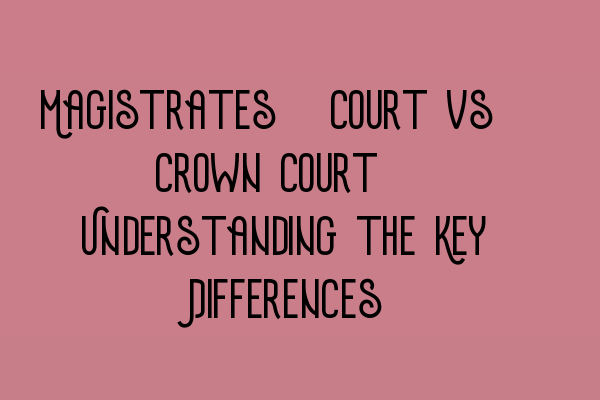Magistrates’ Court vs. Crown Court: Understanding the Key Differences
Welcome to SQE Criminal Law & Practice UK! In the realm of criminal law, there are two main types of courts where cases are heard: Magistrates’ Court and Crown Court. Understanding the key differences between these two courts is crucial for legal professionals and aspiring solicitors alike. In this blog post, we will delve into the distinctive features of each court and shed light on their functions and procedures.
1. The Magistrates’ Court
The Magistrates’ Court is considered the lower court in the criminal justice system. It handles less serious offenses, often referred to as summary offenses. These include minor traffic violations, petty theft, and other minor regulatory violations. Magistrates’ Court also deals with preliminary hearings for more serious offenses that will eventually be passed on to the Crown Court for trial.
The hearings at the Magistrates’ Court are presided over by magistrates, who are volunteers from the local community and have no legal qualifications. They are supported by a legal adviser who provides guidance on legal matters. The decisions made in the Magistrates’ Court are typically reached by majority vote.
Key features of the Magistrates’ Court include:
- Quick resolution of cases
- Less formal procedures
- No jury trials
- Limited sentencing power
- Lower costs
For a deeper understanding of the criminal practice, consider attending our workshops and seminars on criminal practice.
2. The Crown Court
The Crown Court, on the other hand, deals with more serious criminal offenses such as homicides, sexual offenses, and drug trafficking. These offenses are referred to as indictable offenses. A case may also be transferred to the Crown Court for trial if it is deemed too complex or if the Magistrates’ Court does not have sufficient sentencing powers.
Crown Court trials are presided over by a judge, who ensures that the trial is conducted fairly and in accordance with the law. Unlike the Magistrates’ Court, the Crown Court holds jury trials where a panel of 12 jurors determines the defendant’s guilt or innocence.
Key features of the Crown Court include:
- Bigger and more complex cases
- Formal procedures
- Jury trials
- Greater sentencing powers
- Higher costs
For a comprehensive understanding of the SQE criminal law syllabus, we recommend enhancing your knowledge through our SQE Criminal Law Study Group Experience.
Conclusion
Understanding the key differences between Magistrates’ Court and Crown Court is essential for legal professionals and aspiring solicitors. Both courts serve their purposes in the criminal justice system, with the Magistrates’ Court focusing on less serious offenses and the Crown Court handling more severe cases.
To gain further insights into criminal law procedures, it is highly recommended to delve into topics such as criminal evidence rules, public prosecutions in the UK, and UK police procedures in criminal cases.
We hope this blog post has provided you with a solid understanding of the differences between Magistrates’ Court and Crown Court. If you have any questions or would like further information, please feel free to reach out to us.
